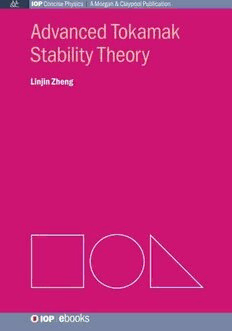
Advanced Tokamak Stability Theory PDF
Preview Advanced Tokamak Stability Theory
Advanced Tokamak Stability Theory Advanced Tokamak Stability Theory Linjin Zheng Institute for Fusion Studies, The University of Texas at Austin, USA Morgan & Claypool Publishers Copyrightª2015Morgan&ClaypoolPublishers Allrightsreserved.Nopartofthispublicationmaybereproduced,storedinaretrievalsystem ortransmittedinanyformorbyanymeans,electronic,mechanical,photocopying,recording orotherwise,withoutthepriorpermissionofthepublisher,orasexpresslypermittedbylawor undertermsagreedwiththeappropriaterightsorganization.Multiplecopyingispermittedin accordancewiththetermsoflicencesissuedbytheCopyrightLicensingAgency,theCopyright ClearanceCentreandotherreproductionrightsorganisations. Rights&Permissions Toobtainpermissiontore-usecopyrightedmaterialfromMorgan&ClaypoolPublishers,please [email protected]. ISBN 978-1-6270-5423-2(ebook) ISBN 978-1-6270-5422-5(print) ISBN 978-1-6270-5738-7(mobi) DOI 10.1088/978-1-6270-5423-2 Version:20150301 IOPConcisePhysics ISSN2053-2571(online) ISSN2054-7307(print) AMorgan&ClaypoolpublicationaspartofIOPConcisePhysics PublishedbyMorgan&ClaypoolPublishers,40OakDrive,SanRafael,CA,94903,USA IOPPublishing,TempleCircus,TempleWay,BristolBS16HG,UK This volume is dedicated with love to my wife and children. Contents Preface ix Acknowledgments xi Author biography xii 1 Tokamak MHD equilibrium 1-1 1.1 The Grad–Shafranov equation 1-2 1.2 Toroidal flux coordinates 1-4 1.3 The tokamak force balance: the hoop force 1-6 Bibliography 1-9 2 Ideal MHD instabilities 2-1 2.1 The global MHD spectrum 2-4 2.2 Internal and external global MHD modes 2-10 2.3 Radially localized modes: the Mercier criterion 2-16 2.4 The ballooning modes and ballooning representation 2-23 2.5 The peeling and free boundary ballooning modes 2-31 2.6 The toroidal Alfvén eigenmodes 2-36 2.7 The kinetically driven MHD modes 2-39 2.8 Discussion 2-43 Bibliography 2-45 3 Resistive MHD instabilities 3-1 3.1 The resistive MHD theory of Glasser, Greene and Johnson 3-3 3.2 The resistive MHD ballooning modes 3-9 3.3 The tearing mode and its coupling to interchange-type modes 3-15 3.4 Discussion: neoclassical tearing modes, etc 3-18 Bibliography 3-19 4 Gyrokinetic theory 4-1 4.1 The general gyrokinetic formalism and equilibrium 4-2 4.2 The electrostatic gyrokinetic equation 4-6 4.3 Electrostatic drift waves 4-7 4.3.1 The slab-like branch 4-8 4.3.2 The toroidal branch 4-12 vii AdvancedTokamakStabilityTheory 4.4 The electromagnetic gyrokinetic equation 4-16 4.5 FLR effects on the interchange modes 4-28 4.6 The kinetic ballooning mode theory 4-34 4.7 Discussion 4-36 Bibliography 4-36 5 Physical interpretations of experimental observations 5-1 5.1 The tokamak confinement modes 5-2 5.2 Enhanced electron transport 5-4 5.3 Transport barriers 5-4 5.4 Nonlocal transport 5-6 5.5 The edge localized modes 5-7 5.6 Blob transport 5-9 5.7 Edge harmonic oscillations 5-10 Bibliography 5-12 6 Concluding remarks 6-1 Bibliography 6-2 Appendix A Derivation of the gyrokinetics equations A-1 A.1 The first harmonic solution of the gyrokinetic equation A-1 A.2 The gyrophase-averaged gyrokinetic equation A-10 A.3 The gyrokinetic vorticity equation A-12 viii Preface OneofthemostfamousquotesfromAlbertEinsteinis‘Themostincomprehensible thing about the world is that it is comprehensible’. Indeed, nature is governed by laws. Our scientific endeavors become meaningful because there are natural laws. Remarkably, even the scientific discoveries of mankind could be considered to follow a law: ‘In the sweat of thy face shalt thou eat bread’ (Genesis 3:19). The more‘bread’adiscoveryyieldsformankind,themore‘sweat’itwillcostmankind to discover it. The most serious challenges humans are facing are food shortages and diminishing energy resources. If natural photosynthesis could be reproduced, the issue of food shortages would be addressed. If controlled nuclear fusion could be achieved with anet energyyield, the energyresource problem would be solved. Unfortunately,thedifficultiesofachievingthesegoalsaredisproportionatelylarge compared to discoveries which are less critically important or which can be harmful to the natural environment. Themostdifficultaspectoftokamakplasmatheoryforcontrollednuclearfusion lies in the fact that the simplicity and beauty underlying the philosophy of physics areoftenlost.Duetothecomplexityofmanycharged-particleproblemswithlong correlation lengths and the complications related to toroidal geometry, tokamak physics is intrinsically difficult. Thanks to the decades of theoretical and experi- mentaleffortsinthisfield,tokamakphysicshasbecomemorecomprehensiblethan everbefore. Thisbook givesan overviewof thesedevelopments, withan emphasis on stability theories in toroidal geometry. The intention of this book is to introduce advanced tokamak stability theory. The readers are expected to have a basic background in plasma physics. We start withthederivationoftheGrad–Shafranovequationandtheconstructionofvarious toroidal flux coordinates.An analyticaltokamak equilibrium theoryispresentedto demonstrate the Shafranov shift and how the toroidal hoop force can be balanced by the application of a vertical magnetic field in tokamaks. In addressing ideal magnetohydrodynamics(MHD)stabilitytheory,thisbookstartswiththeadvanced but most fundamental topic: the structure of ideal MHD equations and the MHD mode spectrum. This is followed by the toroidal theories for interchange modes, ballooning modes, peeling and free boundary ballooning modes, toroidal Alfvén eigenmodes (TAEs) and the kinetically driven modes, such as kinetic ballooning modes and energetic particle modes. For resistive MHD stability theory, we first describe the resistive MHD singular layer theory of Glasser, Green and Johnson, followed by the resistive ballooning and tearing mode theories. The gyrokinetic theory is then introduced. Both the electrostatic and electromagnetic modes are discussed under the gyrokinetic framework. First, the fixed and free boundary ion temperature gradient mode theories are presented. Then, the effects of the finite Larmor radius on the toroidal interchange modes are investigated, followed by the kinetic ballooning theory and a discussion of the kinetic TAE theories. In addition to these advanced theories, this book also discusses the intuitive physics pictures for various experimentally observed phenomena. These basic ix AdvancedTokamakStabilityTheory pictures are particularly important for understanding tokamak discharges. First, a schematic classification is described for various tokamak confinement modes, such asthelowandhighconfinementmodes(L-andH-modes)andtheimprovedenergy confinement mode (I-mode). Then, the physical interpretations are discussed for various core and edge stability/transport phenomena, such as the transport barrier, nonlocal transport, edge localized modes, blob transport and edge harmonic oscillations. With the completion of ITER in sight and the rapid developments in tokamak diagnostic techniques and discharge control methods, great challenges still remain for plasma physics theoreticians. Many critical issues remain open in this field. I hope this book proves helpful in promoting further efforts to address these issues. Dr Linjin Zheng Institute for Fusion Studies The University of Texas at Austin Texas, USA 31 December 2014 x
